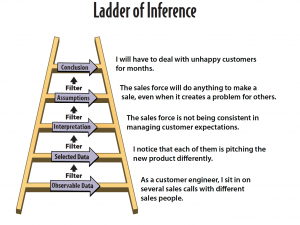Unconscious Assumptions, the Strategic Thinking Enemy
Fill-in-the-blank:
Every day, Sara sneezes when the company dog walks by. Therefore, Sara is allergic to __________________.
Based on the given information, your answer was probably dogs. Thinking that it was a dog is an example of using an assumption to come up with an answer. Assumptions can be defined as inferences and meanings we assign to the observed facts based on values, needs, vested interests, and experience. So with the fill-in-the-blank, you used your experience of seeing Sara sneeze when the company dog walked by her desk to assume that she is allergic to dogs.

Assumptions may not always be negative, but when trying to use your strategic thinking skills, they usually get in the way. This is because strategic thinking involves opening your mind up to new ideas and solutions. So when you assume something about a given scenario, you are closing your mind to the idea of other possibilities.
Chris Argyris(1990) of Harvard University described the process of reasoning as occurring on a “ladder of inference.”
Observable data: At the bottom of the ladder of inference are all of the data related to our topic of interest.
Selected data: We filter the data through our culture, values, needs, experiences, language, and/or belief system and select specific data to notice.
Interpretation: We assign meaning to our observations, placing them in a context which is familiar to us.
Assumptions: We make certain assumptions based on our interpretation of the data.
Conclusions: We draw conclusions from the assumptions – these conclusions may, over time, become fixed beliefs which then act as filters- and we take actions based on the conclusions.
The issue most people encounter is moving up the ladder too quickly. But when we think strategically, we attempt to make this process visible to ourselves and to others by checking our assumptions, thereby creating an opportunity to exchange information and ideas based on the same data and to develop alternative ways of opening up a variety of possible conclusions.
The following is an example illustration of the ladder of inference process, reading from bottom to top. When reviewing it, consider how long it takes you to arrive at the top.
Click on the image of see an enlarged version.

It is often difficult to take a clear-eyed and unbiased look at assumptions, especially those related to values, needs, and vested interests. However, doing so opens up new ideas and solutions. The next time you draw a conclusion, reflect on your decision and CHECK what assumptions may be at play affecting your outcome. Then, consider filtering the data differently, and see what additional options open up for you that you may not have considered. It is always useful to take a step back and ask yourself, “What did I just assume to get from there to here?”
For more information on strategic thinking and a short podcast, click here.
Citation: Argyris, Chris.(2009). Overcoming Organizational Defenses: Facilitating Organizational Learning. New Jersey: Prentice Hall.

Leave a Reply
You must be logged in to post a comment.